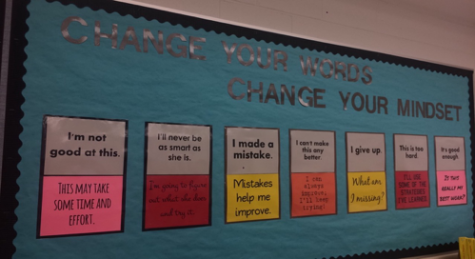Battling Fixed vs. Growth Mindsets
January 25, 2017
The word mindset is defined as a set of beliefs—beliefs about yourself and your most basic qualities, according to Mindset, a book written by Carol Dweck.
Mindset is a simple idea discovered by Carol Dweck, a Stanford University psychologist, through decades of research on achievement and success. Mindset is simple idea that makes all the difference.
Dweck believes that a mindset can be split into two groups; a fixed mindset and a growth mindset. In a fixed mindset, people tend to believe that things like their basic qualities, talents, or intelligence are fixed traits that cannot be changed or improved. Whereas in a growth mindset, people believe that their basic abilities can be developed through hard work and dedication.

Having a growth mindset allows room for people to grow their intelligence and further develop their talent. It creates a love of learning and resilience that is essential to achieve great accomplishments. Not only is a growth mindset healthier than a fixed mindset, but it also creates motivation and productivity in the worlds of business, education, and sports.
On the contrary, a fixed mindset does just the opposite. It does not allow for open mindedness or creative thinking. People with a fixed mindset tend to not enjoy challenges because they fear failure. When someone with a fixed mindset endures a challenge that is “too hard”, they usually experience frustration and end up failing.
“Fixed mindset students run from the error, they do not engage with it,” according to Dweck.
Something very simple that can be done to promote more of a growth mindset is the idea of praising wisely. Praising wisely means to praise improvement and resilience, rather than praising intelligence or talent. Praising the process allows open mindedness and room for growth rather than just praising the end result.
When someone is praised for just the end result, it leads them to not care about the work they had to put in in order to achieve that ending result. Therefore, the process of learning ends up being as cared for.
An example of a fixed mindset is most school’s grading systems. A grading system in education is the process of applying standardized measurements of different levels of achievement in a course. Grades can be assigned as letters, a percentage of a total number of questions answered correctly, or a number out of a possible total.
Grading systems show fixed mindsets because they rank students on their ability to undergo tests and assignments rather than ranking them by their true intelligence.
Fixed mindsets in schools can be stopped. According to Chris Ruiter, the Director of Educational Leadership for Choice Schools Associates, there are seven steps to change schools from a fixed to a growth mindset.
Those seven steps are desire, evaluating situations, dealing with setbacks, challenges, effort, criticism, and success of others.
If schools started following these seven steps, then they would be promoting a healthier environment and instilling a growth mindset in students.
Changing students’ mindsets while they are still young and in school sets them up for a lifetime of success. Next time you are faced with a challenging problem or feeling frustrated, do not give up. Stay positive and look for other ways to approach the task. Handling these minor problems differently changes your mindset, and can essentially change your life.

